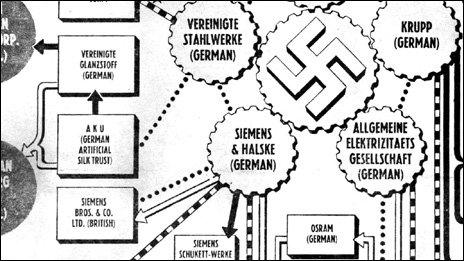MI5 feared Siemens staff had Nazi spy links during WWII
- Published

The file contained a diagram published in US magazine PM suggesting how companies could be linked to the Third Reich
Employees of the German company Siemens were investigated for espionage by MI5, it has been revealed.
for intelligence activities while working for the company in the 1930s and 1940s.
MI5 feared the company, which had branches all over the world, was assisting the Nazi regime in its foreign policy and war objectives.
The files, released by MI5, can be seen at the National Archives in Kew.
British intelligence feared German companies operating in the UK or abroad, particularly in the British Empire, could be used by the German government as part of its broader foreign policy and war effort.
By 1936 the Nazi regime had made it clear "every German man and woman must render service to the Fatherland in time of war and that Germans who live abroad, including those of dual nationality, are bound to serve when called up".
The files show a number of investigations were ordered into individual employees of Siemens, a German industrial conglomerate.
Some of these were requested by Lord Rothschild, who was head of the counter-sabotage unit at MI5 at the time.
'Rabid Nazi cell'
In the run up to World War II, MI5 was concerned about Siemens' operations in the UK.
One branch of the company, Siemens Schukert, which had factories in Ealing and Acton in west London, was described in the files as "a rabid Nazi cell".
There were suspicions that German employees of the firm were involved in intelligence work.
Engineers were said to continually travel around the UK but "no-one knew where they went".
The British branch of the firm was closed down following the start of the war under the 1939 Trading with the Enemy Act.
'Clandestine'
Siemens first came to the attention of MI5 during World War I following an anonymous letter from Chile.
It described how Britons living in Antofagasta in Chile believed the company had a "clandestine wireless installation".
Suspicious activity was also reported in Siemens branches in Georgia, Spain, Switzerland, Egypt, Panama and Argentina during World War I.
- Published26 August 2010
- Published26 August 2010
- Published26 August 2010